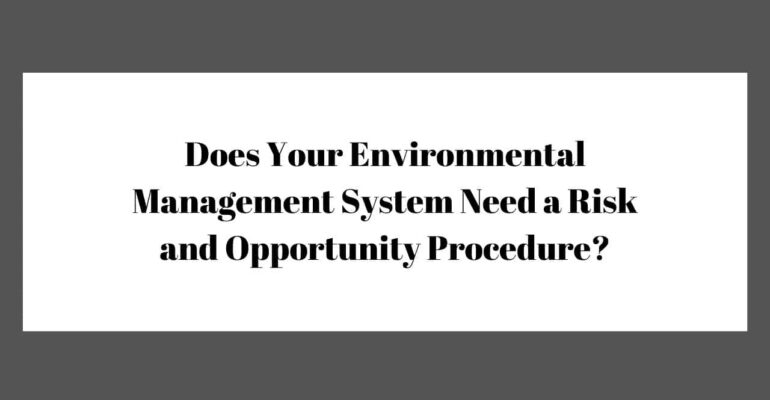Risk and Opportunity Procedure in ISO 14001 2015
There are changes in the new Environmental Management System (EMS), including the risk and opportunity procedure in ISO 14001:2015. In relation, assessing and managing risk had replaced preventive action within the workings of the EMS. Similarly, there are essential benefits to the environment if risk and opportunity were identified and handled correctly. Consequently, this means that risk and opportunity is one of the most crucial elements of an EMS’ performance.
This leads us to the following questions:
- Should you write a procedure to define this process?
- What should be covered to guarantee optimal effectiveness?
- What formats could ensure the fulfilment of the standard’s terms and give optimum results?
In this post, QSE Academy is going to answer those questions and help your organization decide whether you should need a risk and opportunity procedure or not.
Is it Compulsory to Document a Risk and Opportunity Procedure?
In reality, there’s no need to document a risk and opportunity procedure. However, there are advantages to developing one. The ISO 14001:2015 standard specifies that organizations must keep documented information about the risk and opportunity to guarantee the essential confidence that issues have been addressed properly. Likewise, an organization must preserve documented evidence of risks and opportunities that must be tackled.
Furthermore, particular information should be documented about the exact nature of risks and opportunities, as well as actions are taken to address them.
What Should Your Organisation Include in the Risk and Opportunity Procedure?
Risk and opportunity come in various forms. For instance, production staff may view a problem in the production process to be a great risk, a manager may see issues about resources to be the highest risk, while the top management may consider a competitor’s movements as the biggest risk. Hence, it is important to share information and opinions at all levels of an organization.
Consider the following when documenting a risk and opportunity procedure:
- Risk and Opportunity Information
Organizations can use risk forums, risk meetings, risk discussions, and risk logs. In this way, an organization can conduct monthly quality and environmental meetings or board and management meetings. As a result, you can combine and evaluate outputs and ideas. This then develops actions that can alleviate risk and take advantage of the opportunity. Note that the Environmental Management System should record this information. Many amalgamations of these methods can achieve the terms of ISO 14001:2015.
Therefore, a risk and opportunity procedure will benefit your organization if you can find the appropriate process and document it accordingly.
- A Review or Monitoring Method into Your Process
Sometimes it could only take days to resolve risks and opportunities. But sometimes, it could take months. Usually, it takes a long period before organizations realize opportunities. Thus, your organization’s documentation or form facilitates a regular review process, whereby a check can be made against the progress. Additionally, your organization should take further actions if the circumstances of the risk or opportunity have changed.
- Actions and Responsibilities
It is ideal to develop documented information to assure the details of responsibility, as well as specific actions that must be recorded. If not done, your organization will face an increased possibility of failure.
- Risks Coming from Compliance Obligations
Meeting compliance obligations typically creates risks and opportunities. It is important that your organization identifies and maintains records of actions taken against risks and opportunities.
- Experiences
QSE Academy suggests producing documented information to ensure that crucial records can help your organization in the future. Use the documented information to help your employees learn from what your organization experienced. Consequently, it will aid your organization when there’s a periodic review of risk and opportunity.
Align Risk and Opportunity Process with Your Organisation’s Needs
Documenting risk and opportunity process, along with its results, is obligatory under ISO 14001:2015. Nevertheless, your organization must become aware of any procedures that could assist you in detecting and mitigating risk. Your organization should also be capable of pinpointing opportunities to improve the Environmental Management System.
To encourage your employees to think in a particular way, generate a good risk and opportunity procedure. Subsequently, your organization will see improvement in its environmental performance. QSE Academy suggests visiting our previous blog posts to aid your organization in further understanding matters associated with ISO 14001:2015.
Looking for More Resources on ISO 14001?
If you found this article helpful, explore our premium resources designed to help you achieve ISO 14001 certification efficiently:
- 📦 Complete Documentation Package for ISO/IEC 14001 2015: Get all the essential templates and documents you need for fast, easy implementation.
- 🎓 Online Course on ISO/IEC 14001 2015 : Enroll in our comprehensive training to master the key concepts and practical steps toward certification.
- 📋 ISO/IEC 14001 2015 Checklist: Download our detailed checklist to ensure you’ve covered every step of the process.
These resources are tailored to meet your needs and ensure a smooth certification journey. Explore them today and get one step closer to success!






















